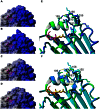Antigenic drift of the pandemic 2009 A(H1N1) influenza virus in A ferret model
- PMID: 23671418
- PMCID: PMC3649996
- DOI: 10.1371/journal.ppat.1003354
Antigenic drift of the pandemic 2009 A(H1N1) influenza virus in A ferret model
Abstract
Surveillance data indicate that most circulating A(H1N1)pdm09 influenza viruses have remained antigenically similar since they emerged in humans in 2009. However, antigenic drift is likely to occur in the future in response to increasing population immunity induced by infection or vaccination. In this study, sequential passaging of A(H1N1)pdm09 virus by contact transmission through two independent series of suboptimally vaccinated ferrets resulted in selection of variant viruses with an amino acid substitution (N156K, H1 numbering without signal peptide; N159K, H3 numbering without signal peptide; N173K, H1 numbering from first methionine) in a known antigenic site of the viral HA. The N156K HA variant replicated and transmitted efficiently between naïve ferrets and outgrew wildtype virus in vivo in ferrets in the presence and absence of immune pressure. In vitro, in a range of cell culture systems, the N156K variant rapidly adapted, acquiring additional mutations in the viral HA that also potentially affected antigenic properties. The N156K escape mutant was antigenically distinct from wildtype virus as shown by binding of HA-specific antibodies. Glycan binding assays demonstrated the N156K escape mutant had altered receptor binding preferences compared to wildtype virus, which was supported by computational modeling predictions. The N156K substitution, and culture adaptations, have been detected in human A(H1N1)pdm09 viruses with N156K preferentially reported in sequences from original clinical samples rather than cultured isolates. This study demonstrates the ability of the A(H1N1)pdm09 virus to undergo rapid antigenic change to evade a low level vaccine response, while remaining fit in a ferret transmission model of immunization and infection. Furthermore, the potential changes in receptor binding properties that accompany antigenic changes highlight the importance of routine characterization of clinical samples in human A(H1N1)pdm09 influenza surveillance.
Conflict of interest statement
The WHO Collaborating Centre for Reference and Research on Influenza has or has previously had collaborative agreements with the International Federation of Pharmaceutical and Manufacturers Associations, Novartis Vaccines & Diagnostics and CSL unrelated to this study. A. Kelso owns shares in CSL. J. McVernon has been a co-investigator on influenza vaccine studies sponsored by CSL, Sanofi and Novartis vaccines. She has received travel grants and honoraria from Novartis vaccines to support scientific presentations at meetings and conferences, and to sit on advisory boards. S. Maurer-Stroh, R.T.C. Lee, E. Job, S. Petrie, J.M. McCaw, and J. Mosse have no competing interests to declare. This does not alter our adherence to all PLoS Pathogens policies on sharing data and materials.
Figures





References
-
- Dawood FS, Jain S, Finelli L, Shaw MW, Lindstrom S, et al. (2009) Emergence of a novel swine-origin influenza A (H1N1) virus in humans. N Engl J Med 360: 2605–2615. - PubMed
-
- WHO (2012) Recommended composition of influenza virus vaccines for use in the 2012–2013 northern hemisphere influenza season. Available: http://www.who.int/influenza/vaccines/virus/recommendations/201202_recom... Accessed 19 September 2012.
-
- WHO (2012) Recommended composition of influenza virus vaccines for use in the 2013 southern hemisphere influenza season. Available: http://www.who.int/influenza/vaccines/virus/recommendations/201209_recom... Accessed 19 September 2012. - PubMed
Publication types
MeSH terms
Substances
LinkOut - more resources
Full Text Sources
Other Literature Sources
Medical

